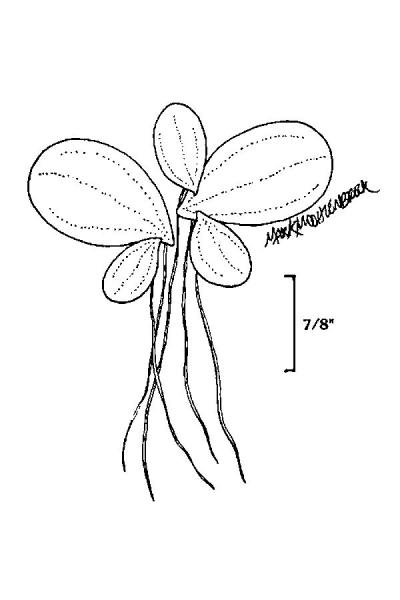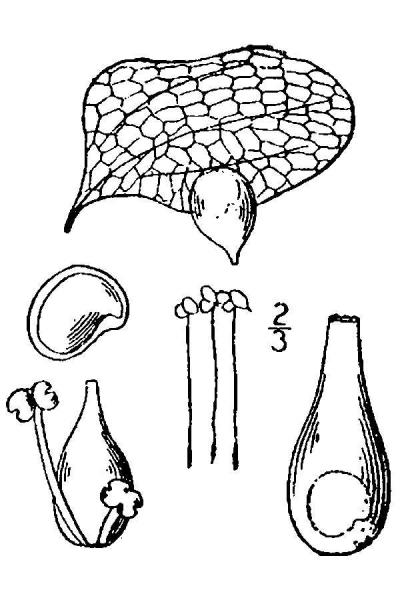Minute Duckweed
Lemna perpusilla Torr.
- Class
- Monocotyledoneae (Monocots)
- Family
- Araceae (Arum Family)
- State Protection
- Threatened
Listed as Threatened by New York State: likely to become Endangered in the foreseeable future. For animals, taking, importation, transportation, or possession is prohibited, except under license or permit. For plants, removal or damage without the consent of the landowner is prohibited.
- Federal Protection
- Not Listed
- State Conservation Status Rank
- S2
Imperiled in New York - Very vulnerable to disappearing from New York due to rarity or other factors; typically 6 to 20 populations or locations in New York, very few individuals, very restricted range, few remaining acres (or miles of stream), and/or steep declines.
- Global Conservation Status Rank
- G5
Secure globally - Common in the world; widespread and abundant (but may be rare in some parts of its range).
Summary
Did you know?
Lemna is the ancient Greek name for this water plant given by Theophrastus, the "Father of Botany". The species name means very small (Fernald 1950) and is a good name for a plant no bigger than the point of a pencil.
State Ranking Justification
There are eight existing populations but there is little detailed information on their size and quality. The plant was recorded in 18 different locations between the late 1800s and the mid-1940s and most of them still need to be rechecked. Five populations no longer exist because their habitat has been destroyed.
Short-term Trends
There are no recent re-surveys to determine short-term trends.
Long-term Trends
This aquatic plant seems to be in decline since there were 18 known populations in the past but now only eight are known but it is being found more now that we know the characters better. Many of the ponds where it occurred are now developed or have been altered from the original natural state.
Conservation and Management
Threats
Specific threats are unknown at this time but many of the ponds on Long Island are subject to shoreline development, pollution and herbicide treatments.
Conservation Strategies and Management Practices
Management needs are unknown at this time.
Research Needs
More collection needs to be done of these small aquatic plants on Long Island to determine the relative abundance of each species.
Habitat
Habitat
These aquatic plants can be found in kettlehole ponds, the surface of rivers, in ponds, springs, rivers and lakes, particularly quiet waters (New York Natural Heritage Program 2012).
Associated Ecological Communities
- Maritime holly forest
(guide)
A broadleaf evergreen maritime strand forest that occurs in low areas on the back portions of maritime dunes. The trees are usually stunted and flat-topped because the canopies are pruned by salt spray and exposed to winds; the canopy of a mature stand may be only 16 to 23 ft (5 to 7 m) tall. The dominant tree is American holly.
- Pitch pine-oak forest
(guide)
A mixed forest that typically occurs on well-drained, sandy soils of glacial outwash plains or moraines; it also occurs on thin, rocky soils of ridgetops. The dominant trees are pitch pine mixed with one or more of the following oaks: scarlet oak, white oak, red oak, or black oak.
Range
New York State Distribution
There are historical records scattered throughout the lower Hudson counties and on Long Island.
Global Distribution
This aquatic plant occurs along the Atlantic coastal states from Vermont south to South Carolina and along the Gulf Coast from Georgia to Louisiana and eastern Texas. It is less common in the upper Midwest and South Central states but becomes more common as it reaches its western limits in Nebraska and Kansas.
Identification Comments
General Description
This tiny aquatic plant has a thallus that is convex on both sides, with a prominent papilla at the node and apex above, and usually with smaller papillae along the midline. They have obliquely obovate leaves with rounded sides, 1-2.5 mm long, commonly 1-2 times as long as wide. The leaves are not anthocyanic. The root tip is pointed and the seeds orthotropous.
Identifying Characteristics
Distinguishing characteristics: thallus convex on both sides, with a prominent papilla at node and apex above, and usually with smaller papillae along the midline, obliquely obovate with rounded sides, 1-2.5 mm, commonly 1-2 times as long as wide, not anthocyanic; root tip pointed; seeds orthotropous. Best life stage for ID: in fruit or flower. Characteristics needed to ID: vegetative plants, fruit or flowers helpful.
Best Life Stage for Proper Identification
The best time to identify this plant is when it is in leaf.
Similar Species
Lemna valdiviana has a more oblong thallus with nearly parallel sides, 2.5-5 mm long, commonly 1.5-3 times as long as wide. Lemna minor has a rounded root tip with amphitropous seeds, thallus symmetrical, flat.
Best Time to See
It can be identified vegetatively June through October. It reproduces during September and October.
- Vegetative
The time of year you would expect to find Minute Duckweed vegetative in New York.
Minute Duckweed Images
Taxonomy
Minute Duckweed
Lemna perpusilla Torr.
- Kingdom Plantae
- Phylum Anthophyta
- Class Monocotyledoneae
(Monocots)
- Order Arales
- Family Araceae (Arum Family)
- Order Arales
- Class Monocotyledoneae
(Monocots)
- Phylum Anthophyta
Additional Common Names
- Duckweed
Additional Resources
Best Identification Reference
Flora of North America Editorial Committee. 2000. Flora of North America north of Mexico. Vol. 22. Magnoliophyta: Alismatidae, Arecidae, Commelinidae (in part), and Zingiberidae. Oxford Univ. Press, New York. xxiii + 352 pp.
Other References
Bookout, Henry. 1996. Sexual reproduction in Lemna Perpusilla Torr. Long Island Botanical Society Newsletter 6(1):1. January - February 1996.
Fernald, M.L. 1950. Gray's manual of botany. 8th edition. D. Van Nostrand, New York. 1632 pp.
Gleason, Henry A. and A. Cronquist. 1991. Manual of Vascular Plants of Northeastern United States and Adjacent Canada. The New York Botanical Garden, Bronx, New York. 910 pp.
Hellquist, C.B. and G.E. Crow 1982. Aquatic vascular plants of New England: part 5. Araceae, Lemnaceae, Xyridaceae, Eriocaulaceae, and Pontederiaceae. New Hampshire Agricultural Experiment Station, University of New Hampshire. Station Bull. 523.
Holmgren, Noel. 1998. The Illustrated Companion to Gleason and Cronquist's Manual. Illustrations of the Vascular Plants of Northeastern United States and Adjacent Canada. The New York Botanical Garden, Bronx, New York.
House, Homer D. 1924. Annotated list of the ferns and flowering plants of New York State. New York State Museum Bulletin 254:1-758.
New York Natural Heritage Program. 2010. Biotics database. New York Natural Heritage Program. New York State Department of Environmental Conservation. Albany, NY.
New York Natural Heritage Program. 2024. New York Natural Heritage Program Databases. Albany, NY.
Reschke, Carol. 1990. Ecological communities of New York State. New York Natural Heritage Program, New York State Department of Environmental Conservation. Latham, NY. 96 pp. plus xi.
Seymour, F.C. 1982. The flora of New England. A manual for the identification of all vascular plants including ferns and fern allies growing without cultivation in New England. Moldenka, Plainfield, New Jersey.
Taylor, Norman. 1915. Flora of the vicinity of New York. Memoirs of the New York Botanical Garden vol. V. New York, NY.
Weldy, T. and D. Werier. 2010. New York flora atlas. [S.M. Landry, K.N. Campbell, and L.D. Mabe (original application development), Florida Center for Community Design and Research http://www.fccdr.usf.edu/. University of South Florida http://www.usf.edu/]. New York Flora Association http://newyork.plantatlas.usf.edu/, Albany, New York
Links
About This Guide
This guide was authored by: Stephen M. Young
Information for this guide was last updated on: April 18, 2019
Please cite this page as:
New York Natural Heritage Program. 2024.
Online Conservation Guide for
Lemna perpusilla.
Available from: https://guides.nynhp.org/minute-duckweed/.
Accessed July 26, 2024.

